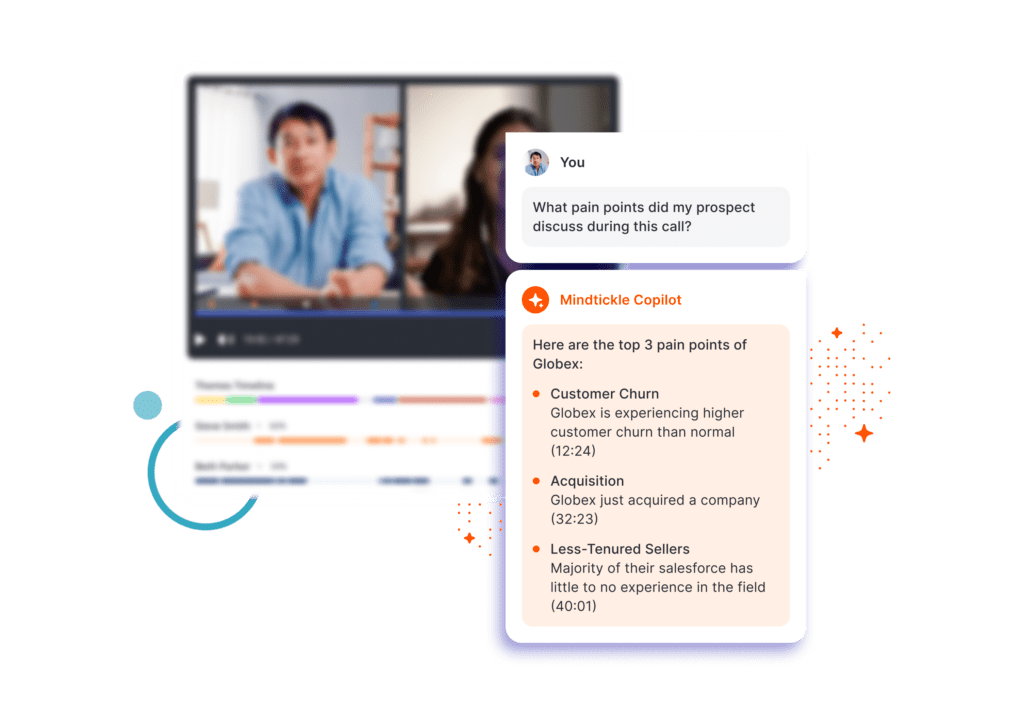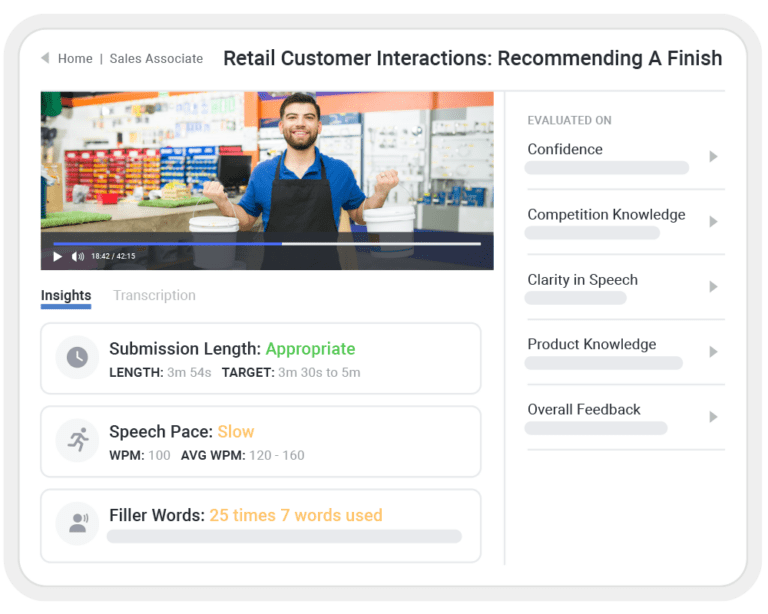Discovery calls are a critical part of the sales cycle. They allow you to build rapport with prospects, learn more about their challenges and priorities, and determine whether you have the right solution to address their problems.
When a sales discovery call goes well, you can guide a qualified prospect further down the funnel. But the deal may be doomed when a discovery call goes off the rails. No pressure, right?
The good news is that with plenty of preparation and the right sales discovery questions at the ready, you can knock your sales discovery calls out of the park every time.
But what sales discovery questions do you need to ask, and is there a certain discovery call template to follow?
In this post, we’ll discuss:
- What sales discovery calls are
- Why they’re important
- 15 must-ask sales discovery questions
- Best practices for more productive sales calls
What is a discovery call?
Every sales rep is responsible for conducting sales discovery calls. But what is a discovery call?
A sales discovery call is the initial conversation a B2B seller has with a buyer who has expressed interest in their offerings. During the call, the seller asks a series of sales discovery questions to quickly uncover the prospects’ pain points and determine whether the prospect is a good fit for the products or services the rep is offering.
Why are discovery calls important?
Discovery calls – when they’re done well – can help sellers achieve the following objectives:
This is foundational to delivering a solution that fits their needs. Recent research found 86% of B2B buyers are more likely to buy when their goals are understood.
It’s important to ensure you’re spending time with prospects that are a good fit for your products or services. Otherwise, you’re wasting your time.
You can do this by delivering value and fresh insight right from the start.
Discovery calls are an opportunity to build trust and pique prospects’ interest so they take the next step. Great sales discovery calls help build and maintain a healthy sales pipeline and accelerate deals.
What are the different types of sales discovery questions?
Productive sales calls are all about asking the right questions. Sales reps ask a wide variety of sales discovery questions. However, they typically fall into one of three categories:
- Closed-ended questions: These are questions that elicit a quick, straightforward answer. For example, a seller may ask, “This is a problem many in your industry face. Does this challenge sound familiar?”
- Open-ended questions: Typically, these sales discovery questions yield more detailed responses. These detailed responses are rich with insights you can use to guide your sales approach.
- Probing questions: These are questions that invite a prospect to tell you more about something. For example, you might ask, “What else can you tell me about that?”
So, which of these three types of sales discovery questions is the best? The truth is, there’s no single type of sales discovery question that’s better than the others. The best approach is to combine the three types of questions to make the conversation natural, interactive, and engaging.
What is the sales discovery process?
Sales discovery calls are a key component of the larger sales discovery process. What exactly is the sales discovery process?
The sales discovery process describes all the steps involved in discovering all you can about a prospective customer. Some of those steps include:
- Researching potential prospects. Modern sellers have plenty of information at their fingertips to learn as much as they can about a prospect before they’ve even made contact.
- Prospect outreach. This could involve making a cold call or reaching out to a prospect who has signaled interest in your offerings.
- Asking sales discovery questions. The right discovery questions for sales enable you to quickly understand a prospect’s needs and pain points and whether your products and services are a good fit for them.
- Answering prospects’ questions. The discovery process is a time for both parties to determine whether it makes sense to move forward. So be ready for your prospects to ask questions.
- Following up. If a prospect is a good fit, it’s important to follow up with them promptly to move the deal forward.
15 sales discovery questions to nail your next call
Asking the right sales discovery questions is key to maximizing the effectiveness and efficiency of your discovery calls.
But what discovery questions for sales do you need to ask?
The truth is, it depends. Your list of sales discovery questions must be personalized to each prospect. However, the following are some of the best sales discovery questions, so they’re a great place to start.
#1 Tell me more about your role at [company name].
The answer to this question can give you insight into what a “day in the life” of your prospect looks like. You’ll understand their day-to-day responsibilities, what types of decisions they make, and where they fit iton the larger organization. They may also share some of their job frustrations – which you may be able to help solve.
All of these insights can help you tailor your sales pitch.
#2 What challenges are you currently experiencing?
You can’t offer a solution if you’re unsure of your prospect’s problems. Your prospect’s response to this question can help you determine if they’re a good fit for your products or services. It can also help you start formulating a customized solution.
#3 Why is this challenge or pain point important to you?
You know your prospect’s challenges. This question can help you understand why this challenge matters.
For example, is there a directive from higher management to solve this challenge because it greatly impacts the entire business? Or is it something that personally impacts your point of contact?
#4 What solution or process are you currently using to address this challenge?
Your prospect may be using a competitor’s solution and looking to make a switch. Or, they may be doing nothing at all to address their problem. It’s important to know so you can adapt your pitch accordingly.
#5 What do you like/not like about your current solution?
Knowing what your prospect likes about their current solution can help you anticipate objections. For example, let’s say there’s a particular feature your prospect loves about their current solution – but your solution doesn’t offer it. This allows you to anticipate their objection and be prepared to overcome it.
On the other hand, understanding the downfalls of your prospects’ current solution can help you position your company as a better option.
#6 What would happen if you did nothing to address this challenge?
Asking this question forces your prospect to really consider the costs of maintaining the status quo. For example, if they don’t find a solution to a problem, they might lose time or money or slip behind the competition.
This question can also help you start to build urgency. In other words, it can help your prospect understand why now is the time to take action.
#7 Where does this rank on your list of priorities?
Is this a problem your prospect needs to address ASAP? Or is it something they can live with for a while – and they’re just starting to casually explore their options? Asking this question can help you understand where your prospect’s head is at in terms of timing and urgency.
#8 What would solving this problem mean for you?
This question can help you understand what success looks like for your prospect. Would solving this problem free up their teams’ time, allowing them to focus on more strategic work? Or would it help their brand stand out in a crowded marketplace—and therefore generate more revenue?
Or perhaps success is more personal. For example, solving this problem may elevate your prospects’ exposure within the company or score them a promotion.
Knowing what success looks like can help you understand how to frame your solution’s value.
#9 Who else wants to solve this problem?
According to Gartner, the typical B2B buying group includes six to 10 stakeholders. This question can shed light on who these stakeholders are and the roles they play in the buying group.
The typical B2B buying group includes up to
For example, you can determine who has the authority to make purchasing decisions and who will influence them.
#10 Why do these stakeholders care about this problem?
Each stakeholder in the buying group will have different needs, opinions, and requirements. This question can help you understand who cares about what. You can use this intel to deliver personalized experiences that resonate with every buying group member.
#11 Can you tell me about a time you faced a similar challenge and successfully addressed it?
This can give you an idea of your prospect’s thought process and their path to solving problems and making decisions. They may also mention roadblocks, which will help you anticipate them.
#12 If I propose a solution and you are on board, what would we need to do to make this happen?
Every business follows its own process for choosing and onboarding a new vendor. A prospect’s answer to this sales discovery question can give you an idea of the steps you can expect to take to get this deal across the finish line. Their answer can also help you anticipate any roadblocks you might encounter along the way.
#13 What is your budget?
Sometimes, there’s some wiggle room when it comes to pricing. But if your prospect’s budget is significantly lower than your solution’s price, it doesn’t make sense to move forward. You’re better off spending time on prospects who can afford your solutions.
#14 What else can you tell me about that?
Sometimes, a prospect will give a short answer to a question, but you want to dig deeper. A probing sales discovery question like this can encourage them to dig deeper.
#15 What questions do you have for me?
Ideally, a discovery call should be a two-way street. You and your prospect should both ask questions to explore whether it makes sense to move forward. If you find your prospect reluctant to ask questions, this prompt can help.
Top sales discovery call best practices
Now, you’ve got a good list of sales discovery questions to use in your next call. Let’s explore some additional best practices to help you nail your next sales discovery call.
Show up prepared to every discovery call
Research shows that 82% of B2B buyers feel sales reps are unprepared. Attending sales discovery calls is a great way to stand out from the crowd.
You can use the internet and prospecting tools to do your research beforehand. That way, you can demonstrate your knowledge and deliver your prospect a new insight or perspective. In addition, you can use the discovery call to ask questions that yield answers beyond what you could uncover on your own.
Schedule enough time for your sales discovery calls
A recent Mindtickle analysis found that the average length of a discovery call is 36 minutes. Consider scheduling your sales discovery calls for 45 minutes. That way, you don’t have to worry about running over. If the call runs short, you can give some time back to the prospect.
The average discovery call is
Ask the right number of sales discovery questions
If you don’t ask enough questions, you won’t walk away with the information you need to qualify the prospect and move the deal forward. If you ask too many discovery questions for sales, you risk overwhelming the prospect.
It’s important to strike the right balance. Our analysis found that on average, sales reps ask 20 questions during discovery calls. If you ask significantly more or less sales discovery questions, you may want to rethink your approach.
Answer prospects’ questions
Sales discovery calls should be a dialog, rather than a monologue. After all, your prospect is also deciding if it makes sense to move forward with learning more about your solution.
Be sure to give your prospects plenty of opportunities to ask their own questions. On average, sales reps answer 12 questions from prospects during sales discovery calls.
Limit yes/no questions
When a prospect answers a question with a simple “yes” or “no,” it can feel like you’re hitting a wall. Try to keep your yes/no sales discovery questions to a minimum. If a prospect does give a quick answer, use a probing sales discovery question like, “Tell me more about that,” to get them to talk more.
Leverage conversation intelligence
Often, sales reps are so focused on taking notes during sales discovery calls that they’re not truly present. This can be a big turnoff to prospects, and it makes it easy for a sales rep to miss an important insight.
Instead, use a conversation intelligence solution to record and analyze your sales discovery calls. That way, you can focus on the meeting itself, rather than taking notes.
Conversation intelligence software and AI make it easy to uncover insights you may have missed during a sales discovery call. For example, with Mindtickle Copilot (Mindtickle’s AI productivity assistant) you can ask a question like, “What competitors did my prospect mention on this call?” Then, you can use the insights to prepare for your next interaction.

A conversation intelligence solution also provides a score for each call with real-time feedback on tone, sentiment, and use of filler words. Sales reps can use this feedback to improve their sales discovery call skills, and managers can look for trends to inform sales coaching opportunities.
Follow up swiftly
Be sure to follow up with your prospects shortly after your sales discovery calls. Conversation intelligence software and AI can help you identify insights that can allow you to personalize your follow up. By following up quickly, you’re more likely to keep prospects engaged.
Deliver proper sales discovery training
Your sellers need to master certain skills to excel at sales discovery calls. Be sure to provide personalized sales discovery training and enablement so your entire sales team can master the necessary skills.

Provide sellers with AI role-plays
Role-plays are a great way for sales reps to practice their sales discovery questions before money is on the line. However, traditional role-plays often require sellers to wait for feedback from their sales managers.
Today, innovative revenue organizations leverage artificial intelligence to provide sellers with realistic, interactive role-play experiences that don’t require a sales manager’s time. With AI role-plays, sales enablement teams can easily spin up different sales scenarios. Then, sales reps can practice with an AI bot in realistic scenarios.

Take your sales discovery calls to the next level with Mindtickle
A sales discovery call can make or break a deal. It’s important to nail every sales discovery call, every time.
Mindtickle is an integrated revenue enablement platform that ensures your sellers have what it takes to lead engaging sales discovery calls that illuminate challenges and entice buyers to take the next step in the purchase journey.
With Mindtickle, you can provide personalized sales discovery training and enablement so your sellers can master the right skills. Mindtickle also features AI role plays, which empower your sales reps to practice their sales discovery skills with an AI-powered bot in realistic sales scenarios. These AI role plays deliver ongoing feedback so sellers can improve their skills before they take them into the field.
Mindtickle also integrates conversation intelligence, which records and analyzes every sales discovery call. Sales reps get immediate feedback they can use to improve outcomes. With Mindtickle Copilot, reps can easily identify insights they can use to appropriately follow up with prospects.
Better Sales Discovery With Mindtickle
Ready to see how Mindtickle can empower you to create an entire team of sales reps who are ready to master any sales discovery call that comes their way?
Request a Demo


 By Helen Waite
By Helen Waite

 By Rahul Mathew
By Rahul Mathew